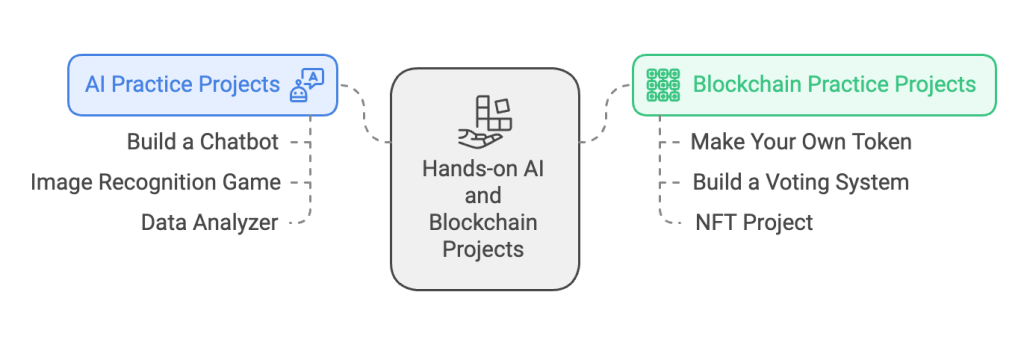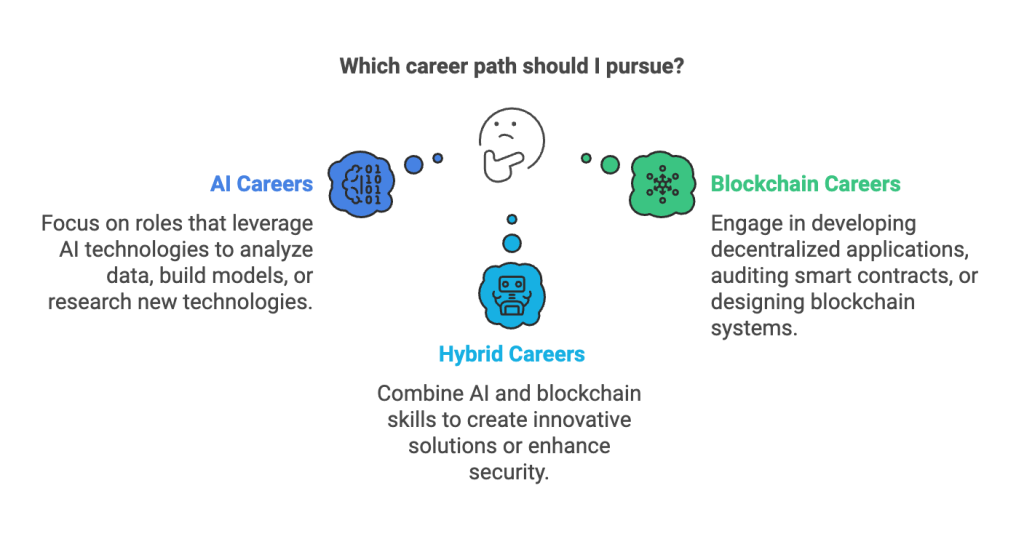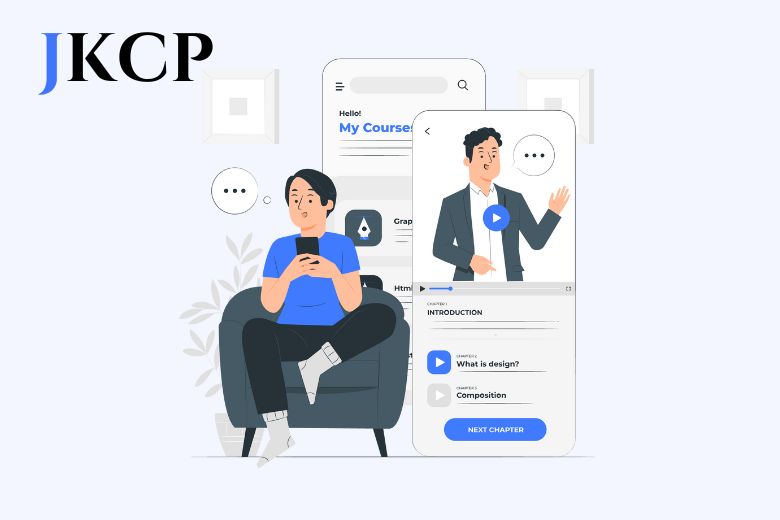How Beginners Can Learn AI and Blockchain for Career Growth
AI (Artificial Intelligence) and blockchain are two of the coolest tech trends right now, but they might feel like an alien language if you’re new. The good news? You don’t need to be a genius or a coding wizard to start learning. Think of it as building a LEGO masterpiece – you begin with the basics and stack up piece by piece. Here’s a super simple guide to help you explore AI and blockchain from scratch to expert level and get those career doors swinging open.
Step 1: Start with the Basics
What is AI?
AI is about teaching computers to “think” and “learn.” Imagine teaching your phone how to predict your next word when you type – it learns from your habits. That’s AI in action!
- Key Ideas:
- Machine Learning (ML): Computers learn from data (e.g., showing app pictures of cats so it recognizes cats later).
- Natural Language Processing (NLP): Making machines like Siri or Alexa understand human language.
What is Blockchain?
Think of blockchain as a magical notebook where everything you write stays there forever, and everyone in the room has a copy. If someone tries to change a page, everyone knows. It’s secure, tamper-proof, and decentralized.
- Key Ideas:
- Blocks: A record of information.
- Chain: These blocks are linked together.
- Decentralization: No single person controls the notebook – it’s shared.

Step 2: Choose Your Tools to Learn
You don’t need to spend a ton of money to start learning. There are plenty of beginner-friendly resources:
AI Resources
- Google’s Machine Learning Crash Course (Free): Simple lessons to understand ML basics.
- FreeCodeCamp: Learn the basics of AI and Python coding.
- Kaggle: Play with real datasets and AI competitions.
Blockchain Resources
- CryptoZombies (Free): Learn to code your first blockchain contract by building games.
- Ethereum.org: Official beginner’s guide to Ethereum and smart contracts.
YouTube Channels: Look up “Simply Explained” or “Dapp University” for easy-to-follow videos.

Step 3: Play with Tools and Practice
Time to get hands-on! Start with simple projects to get the feel of things.
AI Practice Projects
- Build a Chatbot: Use tools like Dialogflow or Python libraries to make a basic Q&A bot.
- Image Recognition Game: Create a program that identifies cats and dogs using free ML libraries like TensorFlow Lite.
- Data Analyzer: Teach AI to predict weather trends using public datasets.
Blockchain Practice Projects
- Make Your Own Token: Use Remix (a Solidity code editor) to create your own cryptocurrency on Ethereum.
- Build a Voting System: Learn how blockchain ensures no one cheats on voting.
- NFT Project: Try creating and minting a basic NFT using platforms like OpenSea or Rarible.

Step 4: Break It Down Like a Recipe
Sometimes, these concepts seem confusing, but if you consider them recipes, they’re easier to digest.
AI Recipe
- Ingredients: Data (e.g., pictures, text), Python programming, and ML libraries (like Scikit-learn).
- Steps: Feed the data into a machine learning model → Train it to recognize patterns → Use it to make predictions.
Blockchain Recipe
- Ingredients: A programming language (like Solidity), a blockchain network (like Ethereum), and a wallet (like MetaMask).
- Steps: Write a contract (rules for your blockchain app) → Deploy it to a test network → Test it with fake transactions.
Step 5: Combine AI and Blockchain
Here’s where things get futuristic. Imagine combining AI’s “smart” capabilities with blockchain’s security. You can create powerful tools like:
- AI-Powered Smart Contracts: Contracts that can learn and adapt based on changing conditions.
- Secure Data Sharing: Use blockchain to store sensitive AI training data securely.
- Fraud Detection: Train AI to spot suspicious behavior in blockchain transactions.

Step 6: Learn Through Communities
Tech isn’t something you learn alone. Join others who are also learning or are already experts.
- AI Communities: Check out Kaggle forums or Reddit’s r/MachineLearning.
- Blockchain Communities: Hang out in Discord groups, Telegram chats, or Reddit’s r/ethdev.
- Hackathons: Join Web3 hackathons like ETHGlobal to build projects with teammates.
Step 7: Build a Portfolio
If you’re going to land a job, people will want to see your resume. Start small, but think big!
- Host Your Code: Use GitHub to share projects you’ve built, like an AI chatbot or a token contract.
- Create a Website: Show off your projects, like your token launch or AI-powered app.
- Collaborate: Contribute to open-source blockchain or AI projects to gain experience.
Step 8: Explore Career Paths
Once you’ve got the basics down and some projects under your belt, explore career opportunities.
AI Careers
- Data Analyst: Use AI to process and interpret large datasets.
- ML Engineer: Build and deploy machine learning models.
- AI Researcher: Develop new AI technologies.
Blockchain Careers
- Blockchain Developer: Create decentralized apps (dApps) and smart contracts.
- Smart Contract Auditor: Test smart contracts for vulnerabilities.
- Blockchain Architect: Design blockchain-based systems for businesses.
Hybrid Careers
- AI-Blockchain Developer: Work on AI-driven blockchain solutions.
- Data Security Specialist: Use blockchain to protect AI systems.
- Decentralized AI Specialist: Build platforms where AI data and models are traded securely.

Step 9: Stay Updated and Keep Learning
Tech evolves fast, so don’t stop learning once you’ve started. Follow the latest news and trends to stay ahead:
- AI News: Platforms like Towards Data Science or Analytics Vidhya are great for new ideas.
- Blockchain News: Check out CoinDesk, Decrypt, and The Defiant.
- Social Media: Follow Web3 and AI thought leaders on Twitter for bite-sized insights.
Conclusion
Starting with AI and blockchain might feel overwhelming, but remember: Every expert was once a beginner. Begin with simple concepts, build small projects, and grow from there. Whether you’re training AI to recognize cats or writing a smart contract for a new app, the key is to stay curious and keep practicing. These fields aren’t just about coding but shaping the future. So grab your laptop, dive in, and build something amazing!




